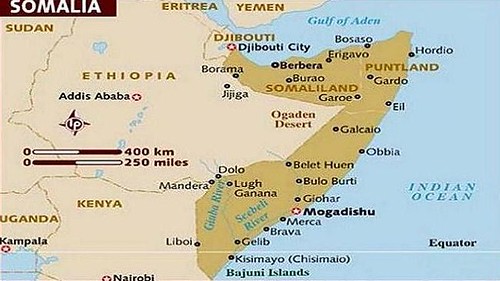
Map of politically fragmented Somalia. Protesters in Somaliland were attacked by police after demonstrating for the further break up of the northern enclave in the Horn of Africa state., a photo by Pan-African News Wire File Photos on Flickr.
Somaliland: So far from Somalia...
Monday, 17 June 2013 16:54
Somaliland with a population of 3.5 million is peaceful, has a functioning civil service, judiciary and police and has held five multiparty elections.
Somalilandsun - Somaliland, on the Gulf of Aden in the Red Sea, is a major contrast to troubled Somalia, its southern neighbour.
The people are fiercely protective of their sovereignty even though the international community has not recognised the country as an independent state.
Since its breakaway from Somalia following the fall of Siad Barre's government in 1991, Somaliland with a population of 3.5 million, has created working institutions such as the judiciary, the police, a functioning civil service. The country has maintained peace and has held five successive multiparty elections.
Somaliland's links with the better-known Somalia are through language and religion, but the culture is different. Somalilanders are trying to balance maintaining their unique identity with borrowing a few things from their southern brothers.
For example, while all vehicles are right hand drives, they still drive on the right side of the road like in the south — unusual anywhere in the world. Countries that drive on the left typically have right-hand drive cars, and vice versa.
In Hargeisa, the capital of Somaliland and the second largest city in the whole of Somalia, three currencies are used interchangeably.
One can use the US dollar and get change in Somaliland shillings. Some hotels also accept the Ethiopian birr.
Money can be changed on the streets, and money changers are everywhere with heaps of Somaliland shillings. It is a sign that the country is free of thieves. Hargeisa is safe compared with Mogadishu; one can walk the streets at night without worrying about their safety.
The 160km road from Berbera to Hargeisa is in relatively good condition, having been built by the Chinese 25 years ago. However, some of the link roads in Hargeisa are gravel roads that give drivers a hard time.
Construction is booming in Somaliland. One of the key features of Hargeisa is the plane that the air force of former president Siad Barre used to bomb the city to pulp during the civil war in 1991.
The plane was shot down and it is now mounted as a monument and a reminder of the dark period the country underwent.
Indeed, Siad Barre is anathema to Somalilanders and the mention of the name elicits epithets at a man who mistreated the people of Somaliland before and during the civil war.
Indegineous Forex in HargeisaState House, where President Mohammed Silanyo lives, is located within the city and ordinary people have easy access to it. Just like Somalia, the Somalilanders love their conversation and can spend hours talking till late in the evening. Although Somaliland does not strike one as a strictly Muslim region, alcohol is not available and city dwellers take their prayers seriously.
Despite having been part of Somalia until 22 years ago, Somaliland has little day-to-day connection with Somalia. The people are proud to have broken away and nearly everybody defends their separateness.
Any suggestion that they should reunite with Somalia is met with scorn, on the grounds that they don't want to import chaos into a country that has remained peaceful for 22 years.
The former British Somaliland gained its independence on June 26, 1960, five days before their Italian-controlled counterpart in the south.
But on July 1, 1960, when Somalia gained independence, Somaliland decided to join hands with its southern neighbour to realise the Greater Somaliland dream. This dream sought to unite the two with three other regions inhabited by ethnic Somali — French Somaliland (currently Djibouti), the Ogaden region in eastern Ethiopia, and the North Eastern Frontier in north-eastern Kenya.
Despite the dream having caused the Shifta War in Kenya in the early 1960s as Kenyans of Somali origin sought to secede, it is now a dead dream and Somalilanders do not entertain any suggestion of unity with Somalia.
Entering and leaving the airport in Berbera is expensive. One has to pay $34 for the visa fees and on leaving, one has to part with $10 for security checks, and a further $34 for airport tax.
No comments:
Post a Comment